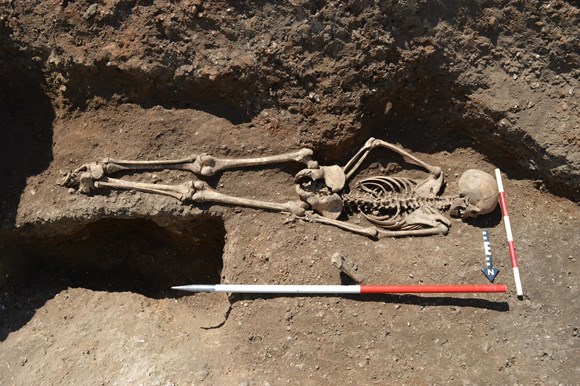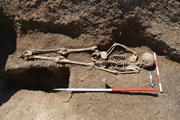
14 Aug 2023
Unusual burial offers insights into the tragic stories of those considered outsiders in Early Medieval England

- Excavations near the village of Conington, Cambridgeshire, uncovered the burial of a young woman aged just 15.
- She was buried face down in a pit, possibly with her ankles tied together.
- This unusual method of burial marks her out as different to other members of the community.
In ninth-century Cambridgeshire, as a community prepared to abandon their settlement, they took down the elaborate entrance gate and replaced it with something unusual. The remains of a young woman, aged just 15, buried face down in a pit and perhaps with her ankles bound together. Evidence suggests that this young woman experienced many hardships during her short life. Her unusual burial gives us insight into a rare Early Medieval burial practice, and perhaps even contemporary attitudes towards those within the community who were considered different.
The young woman was found by archaeologists at an Early Medieval settlement near the village of Conington in Cambridgeshire, part of the National Highways A14 Cambridge to Huntingdon Improvement Scheme, where excavations took place between 2016 and 2018. Her remains have now been studied by experts as part of ongoing analysis by MOLA-Headland Infrastructure (MHI), and now archaeologists can begin to tell her story.
Although by the ninth century, the kingdoms of England were Christian, burial in graveyards associated with churches was not the norm. Early Medieval England did not have set burial traditions, however, one consistent aspect of burials in this period was the body being arranged face up. Being buried face down in a pit marks this young woman out as different.
Analysis of her remains by MOLA osteologists (human bone experts) revealed evidence of childhood malnutrition. She also had a spinal joint disease, made worse by carrying out hard manual labour from a young age. This all suggests she was of low social status. We don’t know exactly how she died, but because of her age, and with her remains showing no evidence for a long, serious illness, she may have died suddenly or unexpectedly.
The pit the young woman was buried in previously held a large wooden post, part of the enclosure’s entry gate, which was taken down as the settlement’s use came to an end. While the reuse of this large hole as a grave could have been purely opportunistic, the face-down placement of the body suggests the location holds much more importance and has similarities with other unusual Early Medieval burials.
Borders and boundaries appear to have been reserved for significant or unusual burials in Early Medieval England. Around 30 miles away at Higham Ferrers (Northamptonshire), a woman was buried face-down in the settlement’s boundary ditch. The date of her burial was late 8th-9th century, and just like at Conington, it took place near the close of the settlement’s use. This individual was missing their arms, head, neck, and fourth lumbar, and has been interpreted as an execution victim.
To be buried face-down is thought to have been a social expression of ‘otherness’, a burial practice reserved for people considered outside of Early Medieval society. This includes those who looked or acted differently from the rest of the community, those of low social status, as well as individuals who suffered violent or unexpected deaths.
MOLA Senior Human Osteologist Don Walker explains:
This burial provides an interesting, albeit tragic, opportunity to view the realities of life, and death, for those seen as outsiders in the past. We will probably never know exactly how this young woman was viewed by the community she grew up in, but the way she was buried tells us she was almost certainly seen as different. Her burial rites may have reflected the nature of her death, or her social identity or that of her family. As well as being buried face down on a boundary, the position of her ankles suggests they may have been tied together. This implies that the community took extra measures to ensure she could not ‘return’ from the grave.
Evidence suggests the burial may have been one of the community’s final acts. Radiocarbon dating showed the young woman died between c.680-880 AD (late seventh to ninth centuries), whilst archaeological work on site revealed all activity at the settlement ended during the eighth and ninth centuries. The settlement’s name, Conington (literally. King’s Town) indicates it functioned as one of many 'administrative centres' for the Mercian kings. It was likely abandoned when the Kingdom of Mercia began to lose power in the early 9th century. If her burial was contemporary with the end of the settlement, it could have been a symbolic final closure of the site.
Contact Information
Lily Hawker-Yates
Communications Officer
MOLA (Museum of London Archaeology)
07590879076
lhawkeryates@mola.org.uk
Notes to editors
A 3D model of the Conington burial is available here: https://sketchfab.com/3d-models/a14-conington-burial-431c301c76c24644b9c01d2c8ce30e9d
About the excavations on the A14:
The archaeology programme of the National Highways A14 Cambridge to Huntingdon improvement scheme took place over two years (2016-2018) and comprised over 40 separate excavations covering around 234 hectares. It revealed one of the richest archaeological landscapes in the UK, unearthing not only 280,947 artefacts but also plants, insects, animal, and human remains. Experts all over the country are now studying these materials to develop a more detailed picture of human occupation in Cambridgeshire across millennia.
More information about the project and discoveries can be found at www.molaheadland.com/a14.
About MOLA Headland Infrastructure:
Two of the most experienced archaeology and built-heritage practices in the UK, MOLA and Headland Archaeology, have combined their expertise to form MOLA Headland Infrastructure. The consortium has been formed specifically to deliver archaeological and heritage services to large, world-class infrastructure projects, that require large numbers of experts, programme certainty and a thorough understanding of the issues facing major construction programmes. Find out more at molaheadland.com.
Timeline for the site:
c.410 AD: Anglo-Saxons settle in Britain after the departure of the Romans. Start of the early medieval period.
c.515 AD: The Kingdom of Mercia, one of the seven Early Medieval kingdoms of England is founded. The capital of Mercia was Tamworth in Staffordshire, but the kingdom expanded in the 6th and 7th centuries and at its heightruled from the Humber River in the north to the Thames in the south.
c.650 AD: the settlement at Coningtonis founded.
c.780-880 AD: The Kingdom of Mercia begins to lose power. Activity at the Conington settlement ends, the young woman is buried.
About MOLA
MOLA is an experienced and innovative archaeological and built heritage practice, Independent Research Organisation, and charity. With over 350 staff working across England, MOLA has been providing independent, professional heritage advice and services for over 50 years. Find out more at mola.org.uk, on Twitter, Facebook and LinkedIn.





